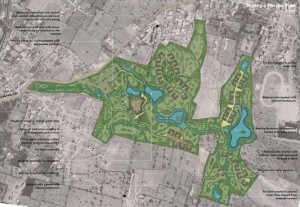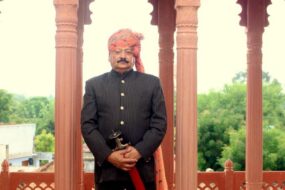A housing project for Mahouts (care-takers) and their elephants, Hathigaon (or elephant village) is situated at the foothill of the Amber Palace and Fort near Jaipur. The primary concern of the master plan was to recreate an ecosystem which addresses the physical and psychological comfort of the elephants and Mumbai-based architects Rahul Mehrotra and Associates were invited to lead the initiative. The settlement was to be a habitat for a hundred elephants, which included ones on active duty, calves, convalescent and ageing animals as well as their mahouts (Elephant Keepers). Limited access for tourists generates necessary revenue for the development. The natural habitat of the Asian Elephant, identified as tropical and semi-deciduous forests in proximity to a water source. In striking contrast is the case of the captive elephants employed in the tourism sector in Amber, 11 kilometres from Jaipur city, which ferry tourists from the foothills to Amber Fort along with a steep incline in a dry, hot and drought-ridden climatic zone. Animal activists have raised concerns over their living conditions for a number of years, taking cognizance of which, the state allotted land to develop an elephant-centric settlement, christened ‘Hathi Gaon’.

Vehicular access is limited to the entrance and a pedestrian pathway leads to the entrance court; a semi-shaded informal plaza for folk performances. Wetlands at the adjoining lower levels form the connection between the plaza and the elevated visitor’s gallery. Physical access for visitors is limited to the zone around the gallery, from where one can view grazing grounds and the bathing reservoir of the elephants. Housing for the elephants and their keepers is developed along the elevated zones of the site, towards the periphery and arranged in clusters. The other built facilities include the veterinary hospital and fodder stores. The design strategy first involved structuring the landscape that had been devastated by its use as a sand quarry by local sand suppliers, to create a series of water bodies to harvest the rain runoff, as this is the most crucial resource in the desert climate of Rajasthan. With the water resources in place, an extensive tree plantation program was carried out together with seeding the site to propagate local species. The water body was a critical component of the design, as it also facilitated the bonding between the mahout and elephant, through the process of bathing – an important ritual both for the health of the elephant as well as their attachment to their keeper.
Establishment of a balanced ecosystem in this degraded site formed the crux of the design, an approximation of the natural habitat of the elephants. Zone-wise interpretation of vegetation, such as a definition of the perimeter and microcosms of grasslands and wetlands, are characteristics that modulate visual access to the elephant habitat. The root system of the indigenous plant palette stabilizes the topsoil layer in this erosion-prone site in conjunction with other soil conservation measures. The housing units are organized in clusters and situated on portions of the site that are not used for the landscape regeneration. Courtyards and pavilions supplement the otherwise small spaces that are allocated in the budget for this essentially low-income housing project. The site planning thus employed a system of clusters to created shared community space at different hierarchies to build a sense of community among the inhabitants.
Hathi Gaon | Amber India | Integrated Design (INDE)
Landscape Architects | Integrated Design (INDE)
Principal Landscape Architect: Mohan S Rao
Principal Architects | RMA, mumbai
Client | Government of Rajasthan
Location | Amber, Rajasthan, India
Area | 35 Hectares




